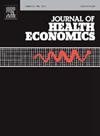当妇女接管:医生、性别和保健服务
IF 3.6
2区 经济学
Q1 ECONOMICS
引用次数: 0
摘要
近几十年来,女医生在经合组织国家的比例有所上升,但我们对医生性别对患者医疗保健使用的影响知之甚少。我们利用准随机分配初级保健提供者(PCP)到现有的PCP实践和患者,并估计女性PCP对卫生保健提供的因果效应。使用奥地利注册数据和差异中的差异策略,我们发现女性pcp产生的收入比男性pcp少15%,看到的病人比男性pcp少7%。将重点转移到患者水平的结果,我们观察到,卫生保健的利用率在分配给女医生后基本保持不变。然而,结果显示,患者更有可能离开PCP实践与女性接班人。我们的研究结果不支持改变PCP的决定是由对女医生治疗的偏好所驱动的观点。相反,我们的分析表明,观察到的差异部分可以解释为女性pcp工作时间更短,尤其是那些面临工作时间限制的人。随着女医生的比例继续上升,可能有必要采取措施增加工作灵活性,以保持广泛获得门诊保健。本文章由计算机程序翻译,如有差异,请以英文原文为准。
When women take over: Physician gender and health care provision
The share of female physicians has risen in OECD countries in recent decades, but we know little about the effects of physician gender on patient health care use. We exploit quasi-random assignment of primary care providers (PCPs) to existing PCP practices and patients and estimate the causal effect of female PCPs on health care provision. Using Austrian register data and a difference-in-differences strategy, we find that female PCPs generate 15% less revenue and see 7% fewer patients than male PCPs. Shifting the focus to patient-level outcomes, we observe that health care utilization remains largely unchanged following assignment to a female physician. However, results show that patients are more likely to leave PCP practices with female successors. Our results do not support the idea that the decision to change PCP is driven by preferences against being treated by female physicians. Instead, our analysis suggests that the observed differences are partly explained by female PCPs working fewer hours, especially those facing working time restrictions. As the share of female physicians continues to rise, measures to increase work flexibility may be necessary to maintain broad access to outpatient health care.
求助全文
通过发布文献求助,成功后即可免费获取论文全文。
去求助
来源期刊

Journal of Health Economics
医学-卫生保健
CiteScore
6.10
自引率
2.90%
发文量
96
审稿时长
49 days
期刊介绍:
This journal seeks articles related to the economics of health and medical care. Its scope will include the following topics:
Production and supply of health services;
Demand and utilization of health services;
Financing of health services;
Determinants of health, including investments in health and risky health behaviors;
Economic consequences of ill-health;
Behavioral models of demanders, suppliers and other health care agencies;
Evaluation of policy interventions that yield economic insights;
Efficiency and distributional aspects of health policy;
and such other topics as the Editors may deem appropriate.
 求助内容:
求助内容: 应助结果提醒方式:
应助结果提醒方式:


